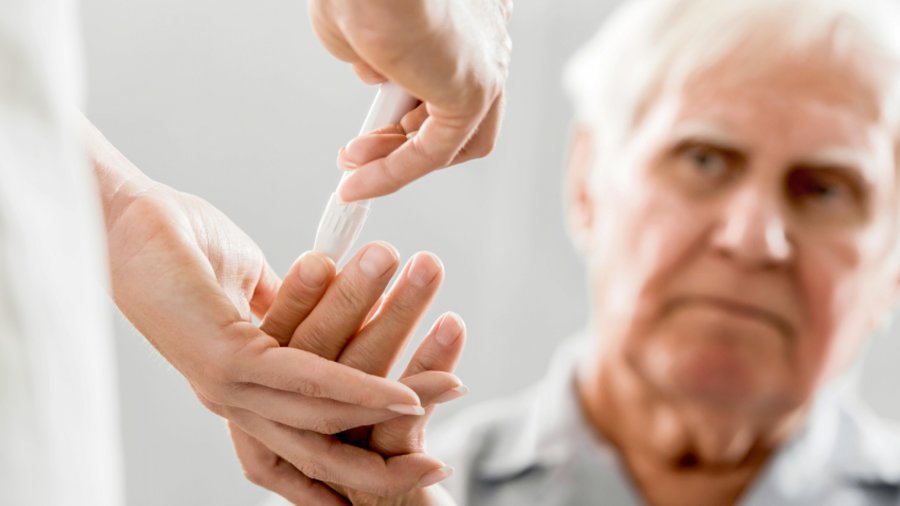
Diabetes Definition
Diabetes is the disease of glucose metabolism. Glucose balance depends on adequate insulin secretion and appropriate sensitivity of insulin receptors. Both insulin sensitivity and insulin secretion are impaired with increasing age.
Some factors that are associated with insulin resistance and pathogenesis of diabetes in the elderly, include
-
Central obesity
-
Induced by various environmental factors
-
Secretion of arginine vasopressin
-
Vitamin D deficiency
-
Hypomagnesemia
-
Decreased muscle mass
-
Reduced physical activity
Symptoms of Diabetes in the Elderly
Many age-related changes affect the clinical presentation of diabetes. These changes can make the recognition and treatment of diabetes problematic, which means, at least half of the diabetic elderly population does not even know they have the disease.
-
The renal threshold for glucose increases with age, and thirst mechanisms are impaired. Thus the symptoms of polyuria and polydipsia may not present early in elderly persons with diabetes.
-
Dehydration is often more common with hyperglycemia because of elderly patients’ altered thirst perception and delayed fluid supplementation.
-
changes such as confusion, incontinence, or complications relating to diabetes are the presenting symptoms.
Screening Diabetes in the Elderly
Screening for diabetes is important in the elderly. The diagnostic criteria for diabetes are similar in the elderly and young adults. A post-challenge or postprandial glucose test may be a better screening strategy than a fasting glucose estimation.
The current American Diabetes Association criteria for a diagnosis of diabetes are two fasting plasma glucose levels ≥126 mg/dl on two separate occasions, a random plasma glucose ≥200 mg/dl with symptoms, or a 2-h oral glucose tolerance test (OGTT) ≥200 mg/dl.
In elderly patients, a 2-h OGTT may be useful in diagnosing diabetes if there is clinical uncertainty.
Managing Diabetes in the Elderly
The main aim of providing diabetes care to the elderly is to achieve comfort, optimal quality of life, resolution of symptoms, and avoid acute complications.
Blood glucose targets vary depending on a patient’s health status and life expectancy. According to the American Diabetes Association (ADA), older adults who are functional, cognitively intact, and have a significant life expectancy should have the same blood glucose targets as younger adults with diabetes. This means they should have a hemoglobin A1c below 7%.
Diet Therapy in Diabetes in the Elderly
The nutritional status of the elderly may well be under attack by several determinants including the difficulties in chewing and swallowing loss of vision, taste, smell, and appetite, and nutrients absorption. An important factor in medical nutritional therapy for elderly patients with diabetes is an optimization of energy intake and macronutrient composition, with consideration of the food source and quality of nutrients.
Malnutrition and vitamin deficiency should be carefully considered.
Obese older adults with diabetes may benefit from modest energy restrictions and an increase in physical activity. A daily multivitamin supplement may be appropriate, especially for those older adults with reduced energy intake.
Progression of diabetes complications may be modified by improving glycemic control, lowering blood pressure, and potentially, reducing protein intake. In individuals with diabetes and macroalbuminuria, reducing protein from all sources to 0.8 g/kg /body weight/ day has been associated with slowing the decline in renal function.
Foods and drinks to limit diabetes include
-
Fried foods and other foods high in saturated fat and trans fat
-
Foods high in salt
-
Sweets, such as baked goods, candy, and ice cream
-
beverages with added sugars
Carbohydrate counting is a meal planning tool for people with diabetes who take insulin, but not all people with diabetes need to count carbohydrates.it can help patients manage their blood glucose levels.
Patients with diabetes should try to limit carbohydrates with added sugars or those with refined grains, such as white bread and white rice. Instead, eat carbohydrates from fruit, vegetables, whole grains, beans, and low-fat or nonfat milk.
Complications of Diabetes in the Elderly
All complications of diabetes can occur in the elderly at higher rates. Some unique syndromes occurring more commonly in elderly diabetic patients. These include:
-
Diabetic neuropathic cachexia
-
Diabetic neuropathy
-
Papillary necrosis
-
Osteoporosis




